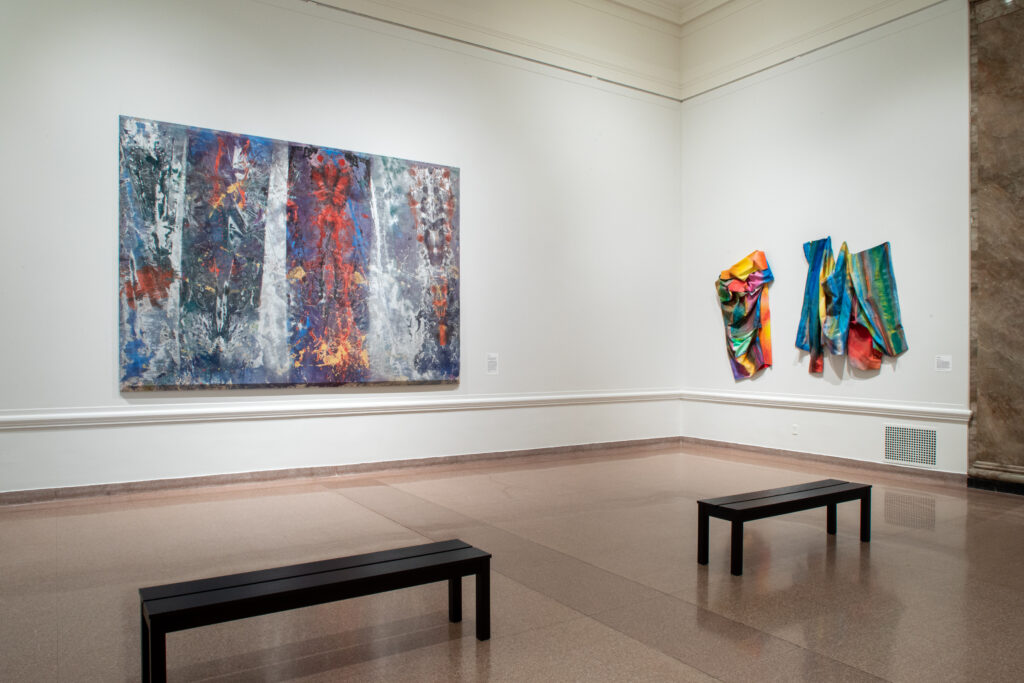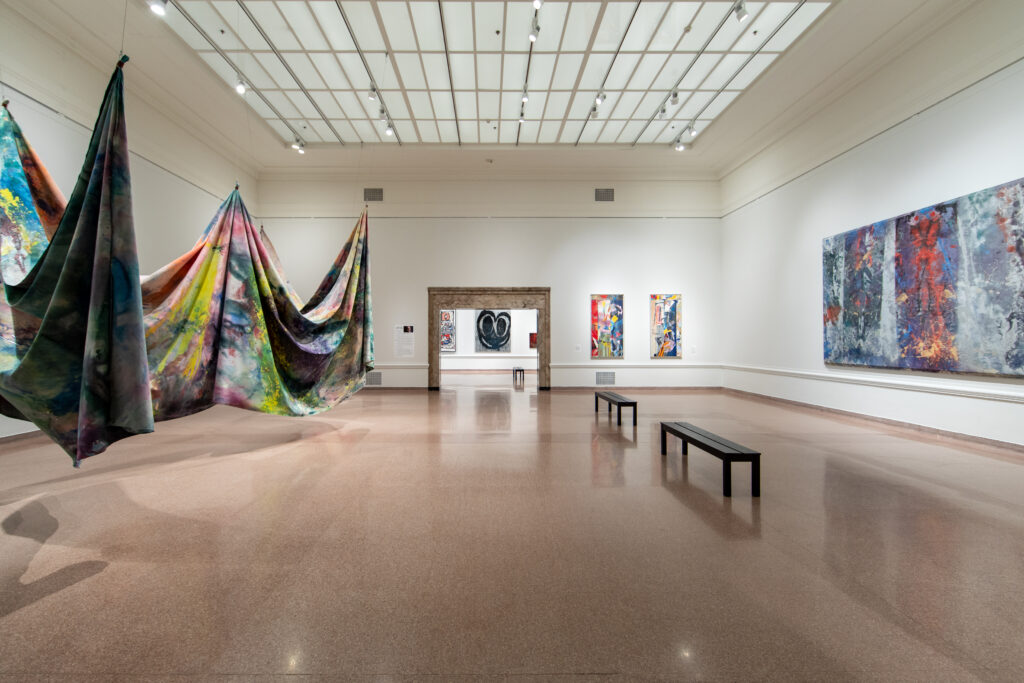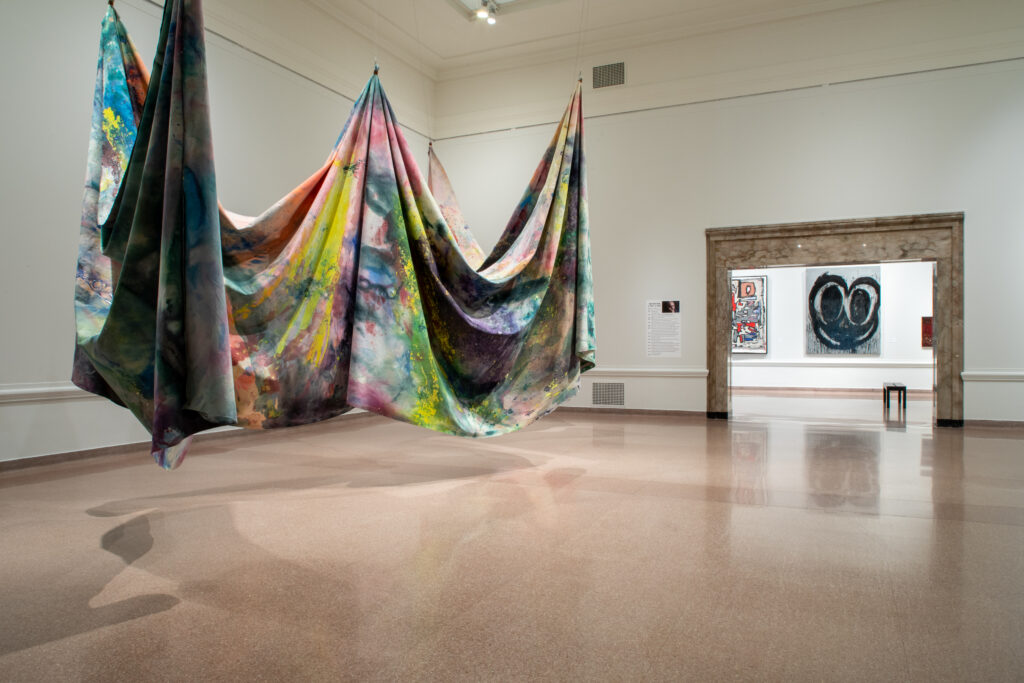My friend Sam Gilliam died this summer on June 25. In the Spring, we spoke on the phone and talked about visiting. But the last time my wife Carolyn and I saw Sam was pre-COVID, in a three-hour conversation in his Washington studio. I was honored and privileged to be asked by his family to speak at a memorial celebration of his life at the Speed Museum on September 18, 2022, and I share these remembrances here.
I miss my friend. He was a brilliant conversationalist, a man of remarkable cultural breadth and knowledge, and – in my opinion – the most important artist to emerge from this part of the world.
Today I broach a subject a lot of people here know more about than I do, and that is Sam Gilliam and his strong connections with Louisville and Kentucky. I can give an overview of his engagement with the Louisville artist community, this museum, and the University of Louisville. But, of course, the much more important connection is Sam’s relationship with his family.
In Louisville, the artist we remember as Sam Gilliam was not Sam Gilliam. That is, he was Sam Gilliam, JUNIOR, the youngest child of Sam Gilliam, Sr. and Estery Gilliam, and the brother of Isabella, Essie, Lizzie, Clenteria, Lillie, Clarence, and Calvin. So, growing up, Sam, Jr. was the brother of seven. He was the uncle of 16 nieces and nephews, father of three, and great-uncle of eight at the time of his mother Estery Gilliam’s death in 1988. When Sam Gilliam, Jr. had a retrospective in 2005 at this museum, his family supported the show financially in memory of Sam Gilliam, Sr. and Estery Gilliam.
So Sam always had excuses to come visit Louisville. By every measure, his is an extraordinary family. My experience of the Gilliam family has always been one of warmth and welcome, concern and giving. This is a family that always memorably extends their embrace.

The Gilliams moved to Louisville from Tupelo, Mississippi, in 1941 when the artist – and he was already an artist – was eight years old. Sam recalled their new home in Louisville: “There was an underlying excitement because there were a lot of playmates and a variety of things to do. We were defensive when we met kids uptown or midtown, and you didn’t let kids who supposedly lived in better neighborhoods overcome you academically. And we had something to do and what we had to do was have an interest in the kind of things that led to careers. Most of the people I grew up with wanted to go on to college and they did. For us, school was the most central part of our lives. None of us would have missed a day of school because it represented fun and play and the entertainment of teachers who were attractive, or attractive enough for us to want to be like them.”
At the Virginia Avenue Elementary School (where he subsequently taught briefly) and at Central High School, Sam had an exceptional education that included teachers like Lyman Johnson at Central High School, an instructor in history, economics, and mathematics. Johnson was a civil rights leader as well as a teacher, and the man who successfully sued the University of Kentucky to integrate, and a leader in innumerable sit-ins and protests. Had the times been more equitable, some of the Central High School faculty would have likely held college professorships.
Outside of school, home life was very disciplined. Sam remembered, “No smoking, no drinking, no card playing, no going to basketball games, everybody home by 9:00PM and all day Sunday in church.” Church was New Zion Baptist, where Lillie Gilliam remains a member of the choir. Sam’s other three sisters, Essie, Clenteria, and Lizzie, were also members of the church and key leaders.
Sam matriculated as a Hite Scholarship student at the University of Louisville in 1952, which had been racially integrated only the year before. He graduated with a B.A. in painting in 1955, and enrolled for his M.A. in 1958, after completing his military service obligation. He finished his Master’s in 1961, while concurrently teaching in the Louisville Public School system.
The Fine Arts Department was chaired by Justus Bier, a German Jewish scholar who’d had close contacts with leading Expressionist artists before he fled from the Nazis. As a man who had experienced prejudice and oppression firsthand, he was very sympathetic and eager to foster the careers of the Department’s few Black students. Charles Crodel was another influential German whose major works were destroyed by the Nazis. He eagerly and enthusiastically pushed for Sam to continue his studies in Munich, and surprised the Gilliam family by showing up at their house at dinnertime one evening to plead his cause.
Another key German-American professor was Ulfert Wilke, who had emigrated in 1938, came to New York, and became a member of the Abstract Expressionist circle and a close friend of Ad Reinhardt, Mark Rothko, Robert Motherwell, and David Smith. Sam recalled, “He was interested in Expressionism and the art of the primitive cultures and he was interested in Pollock. He wasn’t having us paint these things, but he was trying to get everyone to sort of paint in a contemporary way, to paint out of ourselves. He was always forcing people to work with a certain misdirection, that is, to paint on paper, or to paint without drawing. Among Wilke’s crucial lessons was to respect the liquid medium itself.” Sam remembered Wilke saying, “Let it happen, you know, let it be paint. Don’t let it be so precious.”
Among other UofL teachers were Dario Covi, who was impressed by Sam’s analysis of space in Giotto’s Arena Chapel in his Master’s thesis, and Mary Spencer Nay, who was as connected to the wider art world as Wilke, through her summers in Provincetown, Massachusetts.

In a 1982 interview with the Louisville Courier-Journal, Sam recalled the Brown Derby Nightclub in 1958 permitting Gallery Enterprises to craft an art space. Gallery Enterprises, group therapy/workshop/critique club co-created with Bob Douglas, proved to be integral to the careers of many of Louisville’s Black talents. Speculating on why the owner allowed the artists to set up a gallery, Sam remarked, “The intensity that people cared about art was the most driving force. You never stopped painting and you never stopped talking about art either – or arguing about art. When we used to meet we used to talk and a lot of people felt we were crazy because they were talking about women and we were talking about art and music. We would get high on music at a place called New Sounds. It gave you the feeling of what it would be like to be in Paris or be in New York, in the Village.”
“Louisville,” Sam said, “was a very good jazz town. The music gave us all a sense of where to put art. People here talked about music as much as they did art, and a person with a new recording was just as important as a person with a new painting…We would on a Friday evening pull all the tables together in the back room and hold the arts club meeting where we would really begin to discuss who’s better, Clifford Brown or Miles Davis.”
Jazz was important in Sam’s transition from representational art to abstraction. He was introduced to the Washington Color School by the artist Tom Downing. Gilliam confronted Downing about his art. “What is it,” our artist asked, “that this person gets out of painting these dots?” Tom Downing replied, “You are a really an old man to be so young. Those dots are the same thing that Thelonious Monk is doing.”
Sam served as a member of the Board of Governors of the Speed Art Museum, and subsequently as a member of the National Board. He was only the second Black person on the Speed’s Board, and very conscientious about flying in for board meetings. A great source of personal advice and counsel for me when I was director, Sam saved me from more than one major gaffe. Sam had a level of personal concern for me and the multi-part struggle to bring the Museum up to date that was unique for the museum’s board. He was succeeded by his sister Lizzie, also a great board member. Lizzie was the chair of our Community Support and Outreach Committee, which advocated for and sponsored exhibitions and programs of particular interest to the Black community.
Sam’s first showing in an art museum was here in 1961 in an Art Center Annual show. His first one-person show here was in 1974, an exhibition selected by the prominent and influential curator Walter Hopps, who had also included Sam in 1972 as the first Black artist to represent the United States in the Venice Biennale. A 1975 painting, Day One, entered the Speed collection in 1976, the first Gilliam in the collection. And, today, you will see in Gallery 3 in the 1927 building five paintings in the Speed’s collection, including Haiti, a gift of Stephanie, Melissa and Leah Gilliam, Restore, a gift of the artist and partial purchase, and the monumental Carousel Form II, a 2013 gift from Sam. Comparably his generosity to Louisville and Louisville causes was broad: besides the Speed it includes New Zion Baptist Church, the West End School, Lovie’s House (a transitional home for young men aging out of foster care), and the University of Louisville, the recipient of three major paintings. Sam received every award the University of Louisville had to give its alumni, culminating in an Honorary Doctorate of Humane Letters.
Another aspect of Sam’s generosity to his home city was the time he spent teaching and working with University of Louisville students. The Water Tower Art Association, now known as Louisville Visual Art, had a show in which local artists invited national figures to work with them collaboratively. John Whitesell, Professor of Printmaking, working with students and with Sam, made spectacular painted and assembled collage monotypes out of handmade paper for the 1985 Unicorn series.
In 1997, Sam worked with the UofL Department of Geography and Geosciences on a multi-disciplinary course. The class was described as “a transectioning of art, geography, and culture, examining the role of the artist in contemporary society and the nature of space.” Maybe it had something to do with the fact that older sister Lizzie worked in the cartography department at Fort Knox, but the conflicting depictions of space in artistic and geographical terms were enormously compelling for Sam. The artistic results were again outstanding graphics. Sam also had the students draw a line across Louisville to unite the disparate neighborhoods. Sam talked about that class nostalgically, and in recent years when we spoke on the phone Sam would always bring up coming back to work with UofL students yet again. Finally, in 2007 Sam worked again with John Whitesell in creating a print in celebration of the 100th Anniversary of the University of Louisville’s College of Arts and Sciences.

In an interview in the 1990s, Sam remembered his early years in Louisville with gratitude. As his success in Washington blossomed, and he met with mystified critics who were puzzled about his origins, Sam responded:
“Where is this Louisville? … Where was this kind of incubator where you became… some kind of advanced person? The spirit of Louisville… somehow met a certain sort of spirit and a challenge in Washington.”
Sam Gilliam (1933-2022), a selection of works by the artist from the Speed Art Museum’s collection, will be on view until February 26, 2023. The exhibition will be followed by a series of shows celebrating regional artists of color associated with the Gallery Enterprises Art Collective (1957-1961), or its successor, the Louisville Art Workshop (1966-1978). These single-artist exhibits will culminate in a comprehensive treatment of the “Louisville Renaissance” in 2027, the Speed Art Museum’s Centennial Year. Curators involved are Erika Holmquist-Wall, Chief Curator, Dr. fari nzinga, Curator of Academic Engagement and Special Projects, and Sarah Battle, Coordinator of Academic Programs and Publications at the National Gallery of Art in Washington, DC.
Top image: Installation view of the exhibition “Sam Gilliam (1933-2022)” at the Speed Art Museum, courtesy of the museum. Image by Mindy Best.




